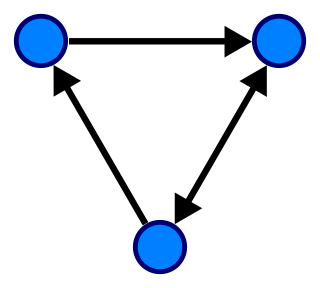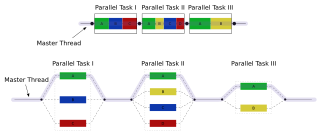
Ronald Linn Rivest is an American cryptographer and computer scientist whose work has spanned the fields of algorithms and combinatorics, cryptography, machine learning, and election integrity. He is an Institute Professor at the Massachusetts Institute of Technology (MIT), and a member of MIT's Department of Electrical Engineering and Computer Science and its Computer Science and Artificial Intelligence Laboratory.
In computer science, the Edmonds–Karp algorithm is an implementation of the Ford–Fulkerson method for computing the maximum flow in a flow network in time. The algorithm was first published by Yefim Dinitz in 1970, and independently published by Jack Edmonds and Richard Karp in 1972. Dinitz's algorithm includes additional techniques that reduce the running time to .

In computer science, a problem is said to have optimal substructure if an optimal solution can be constructed from optimal solutions of its subproblems. This property is used to determine the usefulness of greedy algorithms for a problem.

In computational geometry, the gift wrapping algorithm is an algorithm for computing the convex hull of a given set of points.
MacDraw is a discontinued vector graphics drawing application released along with the first Apple Macintosh systems in 1984. MacDraw was one of the first WYSIWYG drawing programs that could be used in collaboration with MacWrite. It was eventually adapted by Claris and, in the early 1990s, MacDraw Pro was released with color support. MacDraw was the vector-based cousin of MacPaint.
In mathematics, a polylogarithmic function in n is a polynomial in the logarithm of n,

In computer science, a graph is an abstract data type that is meant to implement the undirected graph and directed graph concepts from the field of graph theory within mathematics.
Kenneth Edward Batcher was an American academic who was emeritus professor of Computer Science at Kent State University. He also worked as a computer architect at Goodyear Aerospace in Akron, Ohio for 28 years.

In computer science, the iterated logarithm of , written log* , is the number of times the logarithm function must be iteratively applied before the result is less than or equal to . The simplest formal definition is the result of this recurrence relation:

Charles Eric Leiserson is a computer scientist and professor at Massachusetts Institute of Technology (M.I.T.). He specializes in the theory of parallel computing and distributed computing.
In computational geometry, the multiple line segment intersection problem supplies a list of line segments in the Euclidean plane and asks whether any two of them intersect (cross).

Clifford Seth Stein, a computer scientist, is a professor of industrial engineering and operations research at Columbia University in New York, NY, where he also holds an appointment in the Department of Computer Science. Stein is chair of the Industrial Engineering and Operations Research Department at Columbia University. Prior to joining Columbia, Stein was a professor at Dartmouth College in New Hampshire.
Thomas H. Cormen is an American politician and retired academic. He is the co-author of Introduction to Algorithms, along with Charles Leiserson, Ron Rivest, and Cliff Stein. In 2013, he published a new book titled Algorithms Unlocked. He is an emeritus professor of computer science at Dartmouth College and former chairman of the Dartmouth College Department of Computer Science. Between 2004 and 2008 he directed the Dartmouth College Writing Program. His research interests are algorithm engineering, parallel computing, and speeding up computations with high latency. In 2022, he was elected as a Democratic member of the New Hampshire House of Representatives.
In computer science, the worst-case complexity measures the resources that an algorithm requires given an input of arbitrary size. It gives an upper bound on the resources required by the algorithm.
Donald Bruce Johnson was an American computer scientist, a researcher in the design and analysis of algorithms, and the founding chair of the computer science department at Dartmouth College.
In computer science, an order statistic tree is a variant of the binary search tree (or more generally, a B-tree) that supports two additional operations beyond insertion, lookup and deletion:
In computer science, a mergeable heap is an abstract data type, which is a heap supporting a merge operation.

In parallel computing, the fork–join model is a way of setting up and executing parallel programs, such that execution branches off in parallel at designated points in the program, to "join" (merge) at a subsequent point and resume sequential execution. Parallel sections may fork recursively until a certain task granularity is reached. Fork–join can be considered a parallel design pattern. It was formulated as early as 1963.
In computer science, the analysis of parallel algorithms is the process of finding the computational complexity of algorithms executed in parallel – the amount of time, storage, or other resources needed to execute them. In many respects, analysis of parallel algorithms is similar to the analysis of sequential algorithms, but is generally more involved because one must reason about the behavior of multiple cooperating threads of execution. One of the primary goals of parallel analysis is to understand how a parallel algorithm's use of resources changes as the number of processors is changed.
This is a comparison of the performance of notable data structures, as measured by the complexity of their logical operations. For a more comprehensive listing of data structures, see List of data structures.








